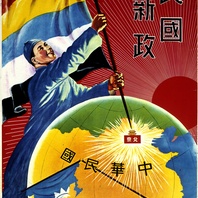
Item
Minguo xinzheng (New government for the Republic)
This poster was almost certainly produced to coincide with the founding of the PGROC in December 1937. The visual trope of the rising sun and city gates of Beijing emitting light are clearly reminiscent of Manchukuo propaganda. Note also the references to a tattered Chinese Nationalist Party (KMT) flag, with its “white sun” emblem. The replacement of this flag with the “five coloured flag ” (wuseqi), which was revived by the PGROC in 1937, was indicative of a general approach under this administration to discredit Nationalist ideologies in favour of more conservative, Confucian ideas. Note also the rather ambitious designs that this regime had on the rest of China (the man is planting his flag on China as a whole, rather than the patchwork of territory in north China over which the PGROC actually ruled).
Read More
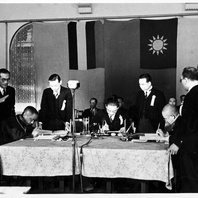
Item
Signing of Japan-Manchukuo-China Joint Declaration
Flanked by courtiers, Zang Shiyi, the Manchukuo ambassador to the RNG (seated to the left), Noboyuki Abe, Japanese ambassador to the RNG (seated to the right), and Wang Jingwei (seated in the centre) sign the Japan-Manchukuo-China Joint Declaration on 30 November 1940, through which RNG China recognised Manchukuo. The Declaration was attached to the Sino-Japanese Basic Treaty, through which Japan formally recognised the RNG. Both documents were signed within the main RNG government compound in Nanjing. The flags of Japan, China and Manchukuo are on the wall behind the men.
Read More
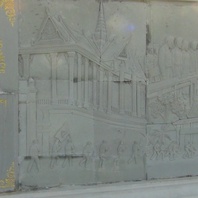
Item
Win-Win Monument bas-relief
The photograph shows a view of bas-relief on the 117-metre-long engraved base of the Win-Win Monument. It depicts the takeover of Phnom Penh in January 1979 by troops from the Kampuchea United Front for National Salvation (FUNSK) and Vietnamese forces. One sees soldiers with a flag of Cambodia passing the Royal Palace. The Win-Win Monument complex – photographed here in January 2020 – was inaugurated in December 2018 to mark the twentieth anniversary of the end of the post-Democratic Kampuchea civil war, with the final defection of the remaining Khmer Rouge factions, thanks to the DIFID policy (“Divide, Isolate, Finish, Integrate, Develop”) also known as the “Win Win” policy of Prime Minister Hun Sen.
Read More
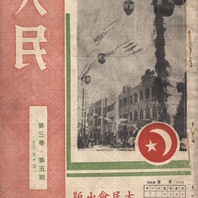
Item
Damin cover image, May 1940
This is the cover image of the magazine Damin 3.3 (May 1940), published by the Daminhui (Great People’s Association) in Nanjing. The Daminhui was a propaganda and mobilization organization established by the Japanese in 1938, which was later folded into Wang Jingwei’s Kuomintang (Nationalist Party). The Daminhui specialised in public expressions of support for the occupation, and employed a staff of Chinese organisers, artists, and writers. The sun-and-moon logo of the Daminhui can be seen on this magazine’s cover.
Read More
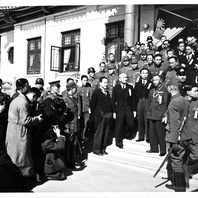
Item
RNG leaders on steps of Government Headquarters, November 1940
Flanked by civilian and military staff, Wang Jingwei, Zang Shiyi (the Manchukuo ambassador to the RNG) and Chu Minyi (RNG foreign minister) pose for photographs in front of the ceremonial hall (litang) in the national government compound in Nanjing after the signing of the Japan-Manchukuo-China Joint Declaration on 30 November 1940, through which RNG China recognised Manchukuo.
Read More
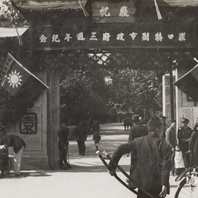
Item
Park in Wuhan, spring 1943
Photograph of a park in Wuhan festooned to “Celebrate the 3rd anniversary of the founding of the Hankou Municipal Government” (Qingzhu Hankou tebie shi zhengfu san zhounian jinian). While Wuhan is often remembered as a centre of anti-Japanese resistance in the early war years, it was also incorporated into the RNG realm in 1940, and became a major political and cultural centre for that administration. Interestingly, the ROC flag shown here still includes the RNG pennant (which read “peace, anti-communism, and nation building”, and which had been added to the flag in 1940), even though Chinese authorities in occupied areas were, from January 1943 onwards, not obliged to include this pennant.
Read More
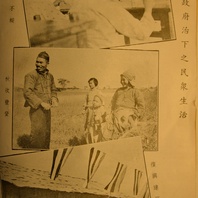
Item
Weixin zhengfu zhixia zhi minzhong shenghuo (The life of the masses under the Reformed Government)
This series of unattributed photographs is taken from the Daminhui publication Xin Zhongguo (New China) 3.1 (January 1940). They are used here to present scenes of life under the rule of the Reformed Government (Weixin zhengfu), or RGROC, which was a “client regime” established in 1938. The RGROC was eventually amalgamated with Wang Jingwei’s RNG in March 1940. The top image is entitled “xian’ge bu chuo” (“studying never stops, even in times of strife”); the middle image is entitled “qiu shou fengdeng” (gathering the autumn harvest); the image at the bottom of the page is entitled “fuxing jianzhu” (renovating buildings). All three are typical images of the sort that the Daminhui promoted in the period between 1938 and 1940, but also display a clear influence from Manchukuo propaganda photography from earlier in the 1930s.
Read More
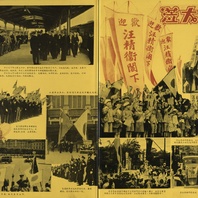
Item
An di Dongjing; li dashiguan (Arriving safely in Tokyo; visiting the embassy)
This photomontage is taken from Huang Qingshu (ed), Wang zhuxi fang Ri jinian huakan (Special pictorial in commemoration of Chairman Wang’s visit to Japan) (Nanjing: Xuanchuanbu, 1941). It includes images of Wang Jingwei arriving in Tokyo during his 1941 visit to Japan, and specifically his visit to the RNG embassy in Tokyo.
Read More
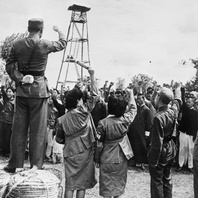
Item
Rural Pacification cadres rousing peasants
Photograph of members of the RNG Central Propaganda Group’s Number 2 Rural Pacification Propaganda Team leading a rural audience in the shouting of slogans. The photograph was possibly produced by the RNG’s Central News Agency. Note the watchtower in the background flying the Nationalist Chinese flag, suggesting this photograph was taken in a “pacified village”.
Read More
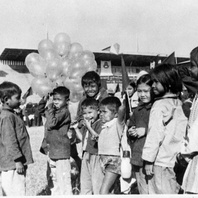
Featured Item
Children at the Olympic Stadium, Phnom Penh
This unattributed image of children with balloons and flags at the Olympic Stadium in Phnom Penh, possibly for a ceremony celebrating the fall of Democratic Kampuchea (i.e, the Khmer Rouge). The group includes about fifteen boys and girls. Groups of adults can be seen in the background. This photograph is part of the collection held by the Agence Khmère de Presse (AKP) and Cambodia’s Ministry of Information. This collection, which documents the early years of the People’s Republic of Kampuchea as photographed by the Vietnamese and a small team of Cambodian photographers, has not yet been classified or indexed.
Read More
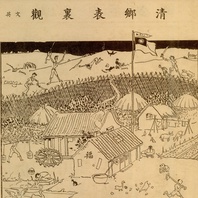
Item
Qingxiang biaoli guan (Within and beyond Rural Pacification)
In this artistic representation of a village which has undergone Rural Pacification, peasants are shown going about their business within the walls of a “pacified” village. Outside the village walls, resistance fighters starve to death and inflict violence upon local residents. The image is taken from the periodical Zhongguo manhua (Chinese Cartoons) 2.1 (October 1942). This was the house magazine of the Chinese Cartoon Associations (Zhongguo Manhua Xiehui).
Read More
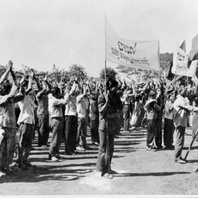
Featured Item
Crowd celebrating the Kampuchea United Front for National Salvation
This photograph shows people cheering the programme of the Kampuchea United Front for National Salvation (KUFNS, also known as FUNSK) [Front or Renakse]. It may have been taken in Kratie on 2 December 1978. It was featured in the publication (French and English versions) entitled The People’s Republic of Kampuchea (1979). This photograph is part of the collection held by the Agence Khmère de Presse (AKP) and Cambodia’s Ministry of Information. This collection, which documents the early years of the People’s Republic of Kampuchea as photographed by the Vietnamese and a small team of Cambodian photographers, has not yet been classified or indexed.